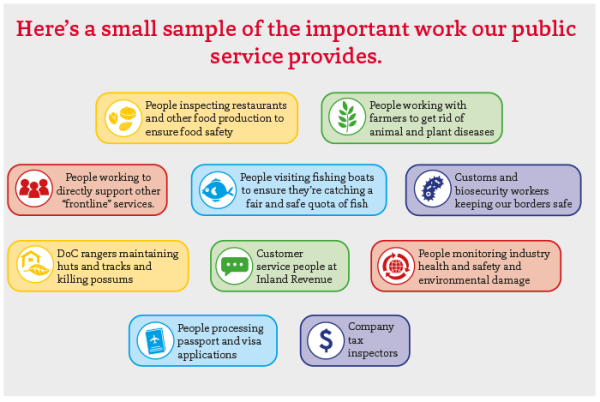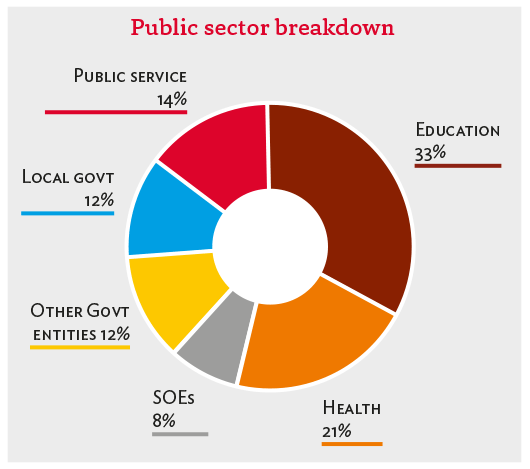To enable you to tackle this narrative when you encounter people who choose to adopt it, here are some key
pieces of information. Knowledge is power, and sharing accurate information can help change minds.
Let's start with the basics
A good place to start is to understand the difference between public service and public sector.
Public service
Public servants, in core government organisations such as ministries and departments, work across more than 250 types of roles nationwide. When we talk about public services, we are talking about vital work such as courts and justice, border protection and biosecurity, maritime and land transport safety, environmental protection, education, cyber security, collecting taxes and paying benefits.
The Public Service includes core government departments, like Conservation, Corrections, and Ministries like Health, Education, Foreign Affairs and Trade, and Social Development.

Public Sector
The public sector goes beyond public servants and includes everyone else who works for the government. These are our allied, technical, scientific and public health workers, scientist, researchers, laboratory assistants, teachers, nurses, doctors, tertiary education staff, and independent watchdogs like the Human
Rights Commission.
Then there’s the departments that support Parliament to run, Crown-owned companies like RNZ, state-owned enterprises, and local councils.
Now let's deal with the statement: "Public servants are all just back-office bureaucrats"
Public servants provide valuable work that keep us all safe and healthy. They ensure we get up-to-date information during emergencies, get taxed correctly, receive an education, provide income support to people, and support for businesses.
Most public servants work in public-facing roles, and the rest are either supporting those services or helping
to make good decisions that support all New Zealanders.
Then there is the classic statement: "But they all just work in offices in Wellington"
There are 62,043 people working in the Public Service, and most of that workforce works outside of Wellington.
How about the statement: "Cut the jobs, downsize the public service; that will save us some money!"
In the last year, the public service has shrunk by 715 people. Public services make up 14% of the public sector.
Proportionately, New Zealand’s public service is the same size as public services in Australia and the UK.

New Zealand spends a lower percentage of its GDP on public services than in Australia and the UK.
To meet both the long terms and temporary needs of the country, the public service is constantly evolving. Public servants work under the government of the day. Working to implement rules and policies that are decided upon by politicians, they are the backbone of this country.
Excessive cuts to the public service may save some money in the short term but the costs of reducing critical
support for people, their whānau, communities and businesses are likely to be far higher over time.
So, next time you hear someone saying those public servants don’t do anything, ask them: “What would we do without them?”
Where do they live?
When we look at all central government, including education and health, the largest proportion of the workforce is in Auckland. Around 113,700 (29.6%) of 384,400 central government employees are
in Auckland.
The largest proportion of the Public Service workforce (44.7%) is located in the Wellington region, which comprises both regional and head office-based staff. This is a decrease from 44.9% in 2021. Other regions have 55.3% of the workforce, led by Auckland (20.7%), Canterbury (9.6%) and Waikato (6.5%).
